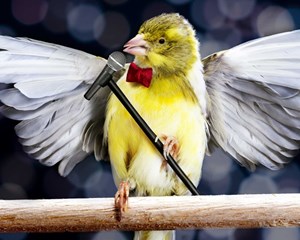(单词翻译:单击)
中英文本
Science & technology
科技板块
The origin of songbirds
鸣禽的起源
The sweet taste of success
成功的甜蜜滋味
Songbirds can detect sugar. That may explain their ubiquity
鸣禽可以探测到糖,这或许可以解释它们无处不在的原因
Imagine a world without bird song. Yet this might have come about if it had not been for a genetic change that happened some 30m years ago, at the beginning of the evolution of the Passeri, to give songbirds their proper name.
想象一个没有鸟儿歌唱的世界。然而,如果不是大约3000万年前雀形目进化初期发生的基因变化给了鸣禽真正的名字,可能这个世界就真的没有鸟儿歌唱。
Birds evolved from carnivorous dinosaurs called theropods. Meat eaters need not detect sugar in the way that, say, fruit eaters do, and genetic analyses of modern birds suggest their theropod ancestor had lost the ability to taste sweetness. Today, however, many birds have sugar-rich diets of nectar or fruit, so perceiving things as sweet is a useful attribute. And research just published in Science by Toda Yasuka of Tokyo University and Maude Baldwin of the Max Planck Institute for Ornithology in Seewiesen, Germany, suggests songbirds can indeed perceive sweetness. This reevolved ability may have been instrumental in their success. Since almost half the bird species now alive are Passeri, that is no small matter.
鸟类是从食肉恐龙进化而来的。肉食者不需要像水果食者那样检测糖分,对现代鸟类的基因分析表明,它们的兽脚亚目祖先已经失去了品尝甜味的能力。然而,今天,许多鸟类以富含糖分的花蜜或水果为食,所以“感知事物是甜的”是一个有用的属性。东京大学的户田康嘉和德国许威森的Max Planck鸟类研究所的莫德·鲍尔温刚刚在《科学》杂志上发表了一项研究,表明鸣禽确实能够感知甜味。这种再进化的能力可能对它们的成功起到了重要作用。因为现在几乎一半的鸟类都是雀形目,这不是一件小事。

Vertebrates' taste-receptor genes normally include three that encode proteins called T1R1, T1R2 and T1R3. The taste receptors themselves are formed from pairs of these proteins. Receptors for sweetness are a combination of T1R2 and T1R3. Birds, however, lack the gene for T1R2. Presumably, it was lost by their theropod ancestors, which did not need it. Dr Toda's and Dr Baldwin's experiments have shown how this loss was reversed.
脊椎动物的味觉受体基因通常包括三个编码T1R1、T1R2和T1R3的蛋白质。味觉感受器本身就是由这些成对的蛋白质组成的。甜味受体是T1R2和T1R3的组合。然而,鸟类缺乏T1R2基因。据推测,它是兽脚亚目动物的祖先遗失的,它们并不需要它。户田博士和鲍德温博士的实验显示了这种损失是如何逆转的。
The pair's first study, published in 2014, was on hummingbirds, which feed on nectar from flowers. It found that hummingbirds regained the ability to taste sugars via mutations in the genes for T1R1 and T1R3. The receptor formed by combining T1R1 and T1R3 normally detects umami, a savoury flavour typical of meat. In hummingbirds, these mutations allow this receptor to detect sugars, too. Dr Toda and Dr Baldwin therefore wondered whether that was also the case for songbirds.
他们的第一个研究发表于2014年,研究对象是以花蜜为食的蜂鸟。研究发现,蜂鸟通过T1R1和T1R3基因的突变重新获得了尝糖的能力。由T1R1和T1R3组合而成的受体通常能检测鲜味,即肉的一种典型的咸味。在蜂鸟身上,这些突变也让这种受体能够检测糖。户田博士和鲍德温博士因此想知道鸣禽的情况是否也是如此。
译文由可可原创,仅供学习交流使用,未经许可请勿转载。
词语解释
1.ubiquity 普遍存在
The ubiquity of the quality culture should extend to the customer.
质量文化氛围的普遍性应该扩展至客户。
2.evolve from 由……进化
Birds are widely believed to have evolved from dinosaurs.
鸟类普遍被认为是从恐龙进化而来的。
3.feed on 以……为食
Butterflies feed on a sweet liquid produced by flowers.
蝴蝶以花朵产生的甜液为食。
4.reverse 颠倒
In 2002 economic growth went into reverse.
2002年,经济增长发生了逆转。


